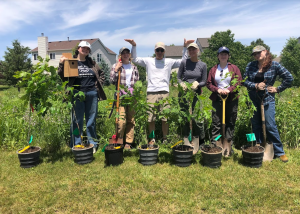
Adventures in Conservation – CLIP 2024 Week 1
Welcome to the first week of TLC’s 2024 Conservation Leader Internship Program (CLIP)! This week’s update is provided by CLIP’s 2024 crew leader, Emma. This is my second year leading the summer internship program for TLC, and I am eager to share my passion for environmentalism with the other 4 CLIPsters over another activity-packed summer!
Our first day at CLIP started on Wednesday, where we were introduced to VGS and GIS collector tools, as well as invasive plant identification. These skills will be needed for the rest of the summer as we complete restoration projects and workdays at TLC sites. Using our new clippers, we collected samples of a few invasives, like honeysuckle and buckthorn, throughout Hennen. These cuttings will be added to our plant identification journals, which we will continue to build up throughout the summer.
 After lunch, we got to partake in a CLIP tradition–a team-building exercise, which involved working together to craft a structure out of materials found outdoors at Hennen. Our group worked together to construct a spacious shack, protected from the elements with burdock leaves. Then it was off to Spring Hollow to pull Dame’s Rocket! Spring Hollow is a beautiful location, full of less common natives like lady slipper orchid and marsh marigold. It was a great demonstration of how rich and diverse an ecosystem can be after years of management.
After lunch, we got to partake in a CLIP tradition–a team-building exercise, which involved working together to craft a structure out of materials found outdoors at Hennen. Our group worked together to construct a spacious shack, protected from the elements with burdock leaves. Then it was off to Spring Hollow to pull Dame’s Rocket! Spring Hollow is a beautiful location, full of less common natives like lady slipper orchid and marsh marigold. It was a great demonstration of how rich and diverse an ecosystem can be after years of management.
Thursday was dedicated to herbicide training and safety, led byTLC’s restoration ecologist, Megan Oropeza! We covered the different types of herbicide and when to use them, as well as how the herbicide targets plant cells specifically. We then practiced mixing our first batches of Milestone in the herbicide sprayer backpacks, making sure to follow all safety protocols. These backpacks were then taken to Prairie Ridge, where we tackled crown vetch, teasel and a few invasive thistles. Prairie Ridge is a great location for first-time invasive removal because it is a long, flat, relatively unbroken stretch of land that can be easily traversed. The CLIP team was able to practice their herbicide application methods in the field, as well as their transecting technique. Effectively eradicating such a large area requires teamwork, organization and communication. Without the disturbances caused by these invasives, this ecosystem will hopefully host a healthy abundance of native forbs, sedges and grasses in the future. Before lunch, we took another nature walk through Hennen, where we collected more samples for our field journals, including Rosinweed and native rose.

On Friday, the interns participated in their first project: Project Quercus. This event, led by Dave Zeiger, TLC’s oak conservation specialist, focuses on restoring local landscapes to their original oak-dominated environments, one tree at a time. After a quick tutorial by Dave, we were able to plant seven red, white and bur oak saplings in a suburban area that had previously only hosted grass. It was so rewarding to be contributing to the restoration of such a disturbed ecosystem. Dave had shown us a series of maps recording the dramatic loss of oak species – and subsequent fragmentation of oak ecosystems – after European colonization. While we may not restore the land to its original glory, we can help reduce further loss and fragmentation.

Our first half-week has been incredibly fun and busy. The CLIP team has encountered a lot of new beginnings in just three days, and we are excited for a summer packed with unique experiences and opportunities!